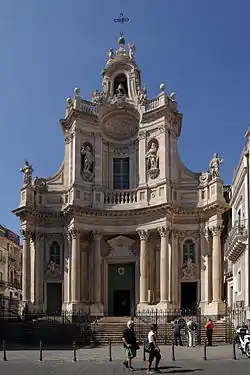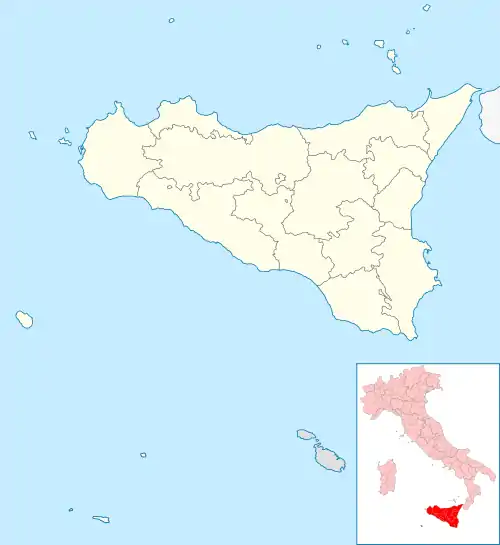Basilica della Collegiata
The Basilica della Collegiata (also known as Santa Maria dell'Elemosina) is a church in Catania, Sicily, southern Italy. Finished in 1768, it is an example of Sicilian Baroque.
| Basilica della Collegiata | |
|---|---|
| Santa Maria dell'Elemosina | |
 Façade of the Basilica | |
 Basilica della Collegiata Map of Sicily | |
| 37°30′15.2″N 15°5′11.5″E | |
| Country | Italy |
| Denomination | Roman Catholic Church |
| Architecture | |
| Style | Sicilian Baroque |
| Completed | 1768 |
%252C_Soffitto_della_Collegiata_-_Foto_Giovanni_Dall'Orto%252C_5-July-2008.jpg.webp)
The church was built in the early 18th century, after the earthquake of 1693 that had destroyed most of the city.
Architecture
The design of the church is attributed to Angelo Italia (1628–1700), who changed the orientation of the previous edifice destroyed by the earthquake, in order to have it facing the new via Uzeda (current Etnea Street) according to the rebuilding plan of the city. The façade, designed by the polish architecte Stefano Ittar (1724–1790), is one of the most notable examples of late Baroque in Catania.
It has two orders, the first of which featuring six stone columns, surmounted by a balustrade. The second order has a large central window, with, at the sides, four large statues of St. Peter, St. Paul, St. Agatha and St. Apollonia. Over the second floor is a central element housing the bells.
The church is accessed through a large staircase on which, delimiting the parvise, is a wrought iron parapet.
Interior
The interior follows a common basilica plan, with a nave and two aisles divided by two pilasters, and three apses. The central apse is rather elongated to house the rectory.
The right aisle is home to a baptistery and three altars with canvasses of saints. At the end of the aisles is the Immaculate altar, preceded by a marble balaustrade, over which is a marble statue of the Madonna. In the apse of the nave is the high altar, with an icon of the Virgin with a Child, a copy of a Byzantine original in the sanctuary of Biancavilla. Behind the altar are an 18th-century wooden organ and a wooden choir.
The left aisle, in the apse area, houses the Holy Sacrament Chapel, with a marble altar. The vaults and the dome were frescoed in 1896 by Giuseppe Sciuti with scenes of the Life of Mary, Angels and Saints.
See also
Sources
| Wikimedia Commons has media related to Santa Maria dell'Elemosina (Catania). |
- Rasà Napoli, Giuseppe (1984). Guida alle Chiese di Catania. Catania: Tringale Editore.
- Boscarino, Salvatore (1986). Sicilia barocca - Architettura e città 1610-1760. Rome: Officina Edizioni.